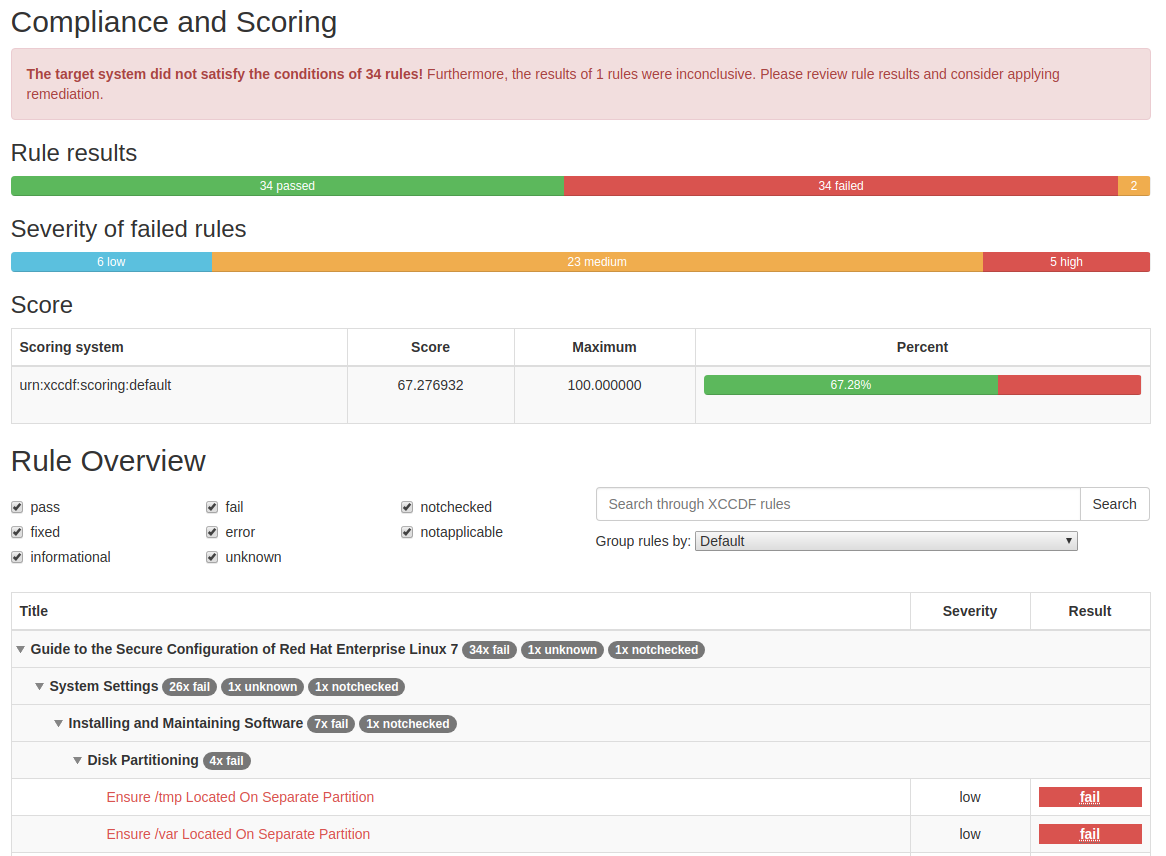The purpose of this project is to create security policy content for various platforms -- Red Hat Enterprise Linux, Fedora, Ubuntu, Debian, ... -- as well as products -- Firefox, Chromium, JRE, ... Our aim is to make it as easy as possible to write new and maintain existing security content in all the commonly used formats.
"SCAP content" refers to documents in the XCCDF, OVAL and Source DataStream formats. These documents can be presented in different forms and by different organizations to meet their security automation and technical implementation needs. For general use we recommend Source DataStreams because they contain all the data you need to evaluate and put machines into compliance. The datastreams are part of our release ZIP archives.
"Ansible content" refers to Ansible playbooks generated from security profiles. These can be used both in check-mode to evaluate compliance, as well as run-mode to put machines into compliance. We publish these on Ansible Galaxy as well as in release ZIP archives.
"Bash fix files" refers to Bash scripts generate from security profiles. These are meant to be run on machines to put them into compliance. We recommend using other formats but understand that for some deployment scenarios bash is the only option.
We want multiple organizations to be able to efficiently develop security content. By taking advantage of the powerful build system of this project, we avoid as much redundancy as possible.
The build system combines the easy-to-edit YAML rule files with OVAL checks, Ansible task snippets, Bash fixes and other files. Templating is provided at every step to avoid boilerplate. Security identifiers (CCE, NIST ID, STIG, ...) appear in all of our output formats but are all sourced from the YAML rule files.
We understand that depending on your organization's needs you may need to use a specific security content format. We let you choose.
We use an OpenControl-inspired YAML rule format for input. Write once and generate security content in XCCDF, Ansible and others.
prodtype: rhel7
title: 'Configure The Number of Allowed Simultaneous Requests'
description: |-
The <tt>MaxKeepAliveRequests</tt> directive should be set and configured to
<sub idref="var_max_keepalive_requests" /> or greater by setting the following
in <tt>/etc/httpd/conf/httpd.conf</tt>:
<pre>MaxKeepAliveRequests <sub idref="var_max_keepalive_requests" /></pre>
rationale: |-
Resource exhaustion can occur when an unlimited number of concurrent requests
are allowed on a web site, facilitating a denial of service attack. Mitigating
this kind of attack will include limiting the number of concurrent HTTP/HTTPS
requests per IP address and may include, where feasible, limiting parameter
values associated with keepalive, (i.e., a parameter used to limit the amount of
time a connection may be inactive).
severity: medium
identifiers:
cce: "80551-5"Our security content can be used to scan bare-metal machines, virtual machines, virtual machine images (qcow2 and others), containers (including Docker) and container images.
We use platform checks to detect whether we should or should not evaluate some of the rules. For example: separate partition checks make perfect sense on bare-metal machines but go against recommended practices on containers.
The preferred method of installation is via the package manager of your distribution. On Red Hat Enterprise Linux and Fedora you can use:
yum install scap-security-guideOn Debian (sid), you can use:
apt install ssg-debian # for Debian guides
apt install ssg-debderived # for Debian-based distributions (e.g. Ubuntu) guides
apt install ssg-nondebian # for other distributions guides (RHEL, Fedora, etc.)
apt install ssg-applications # for application-oriented guides (Firefox, JBoss, etc.)Download pre-built SSG zip archive from the release page. Each zip file is an archive with ready-made SCAP source datastreams.
We maintain a COPR repository that provides unofficial builds of latest versions of openscap, scap-security-guide, scap-workbench and openscap-daemon. The packages are suitable for use on Red Hat Enterprise Linux 6 and 7 and CentOS 6 and 7.
See https://copr.fedorainfracloud.org/coprs/openscapmaint/openscap-latest/ for detailed instructions.
If SCAP Security Guide is not packaged in your distribution or if the
version that is packaged is too old, you need to build the content yourself
and install it via make install. Please see the BUILD.md
document for more info. We also recommend opening an issue on that distributions
bug tracker to voice interest.
We assume you have installed SCAP Security Guide system-wide into a standard location as instructed in the previous section.
There are several ways to consume SCAP Security Guide content, we will only go through a few of them here.
The oscap tool is a low-level command line interface that comes from
the OpenSCAP project. It can be used to scan the local machine.
oscap xccdf eval --profile xccdf_org.ssgproject.content_profile_rht-ccp --results-arf arf.xml --report report.html --oval-results /usr/share/xml/scap/ssg/content/ssg-rhel7-ds.xmlAfter evaluation, the arf.xml file will contain all results in a reusable
Result DataStream format, report.html will contain a human readable
report that can be opened in a browser.
Replace the profile with other profile of your choice, you can display all possible choices using:
oscap info /usr/share/xml/scap/ssg/content/ssg-rhel7-ds.xmlPlease see the OpenSCAP User Manual for more info.
The SCAP Workbench is a graphical user interface for SCAP evaluation and customization. It is suitable for scanning a single machine, either local or remote (via SSH). New versions of SCAP Workbench have SSG integration and will automatically offer it when the application is started.
Please see the SCAP Workbench User Manual for more info.
oscap-ssh comes bundled with OpenSCAP 1.2.3 and later. It allows scanning
a remote machine via SSH with an interface resembling the oscap tool.
The following command evaluates machine with IP 192.168.1.123 with content
stored on local machine. Keep in mind that oscap has to be installed on the
remote machine but the SSG content doesn't need to be.
oscap-ssh root@192.168.1.123 22 xccdf eval --profile xccdf_org.ssgproject.content_profile_usgcb-rhel6-server --results-arf arf.xml --report report.html /usr/share/xml/scap/ssg/content/ssg-rhel6-ds.xmlTo see a list of available playbooks, run:
# ls /usr/share/scap-security-guide/ansible/
...
ssg-rhel6-role-standard.yml
ssg-rhel6-role-stig-rhel6-server-upstream.yml
ssg-rhel6-role-usgcb-rhel6-server.yml
ssg-rhel7-role-C2S.yml
ssg-rhel7-role-cjis-rhel7-server.yml
ssg-rhel7-role-common.yml
ssg-rhel7-role-docker-host.yml
ssg-rhel7-role-nist-800-171-cui.yml
...These roles are generated from SCAP profiles available for the products.
To apply the playbook on your local machine run: (THIS WILL CHANGE CONFIGURATION OF THE MACHINE!)
ansible-playbook -i "localhost," -c local /usr/share/scap-security-guide/ansible/ssg-rhel7-role-rht-ccp.ymlEach of the Ansible playbooks contain instructions on how to deploy them. Here is a snippet of the instructions:
...
# This file was generated by OpenSCAP 1.2.16 using:
# $ oscap xccdf generate fix --profile rht-ccp --template urn:xccdf:fix:script:ansible sds.xml
#
# This script is generated from an OpenSCAP profile without preliminary evaluation.
# It attempts to fix every selected rule, even if the system is already compliant.
#
# How to apply this remediation role:
# $ ansible-playbook -i "192.168.1.155," playbook.yml
# $ ansible-playbook -i inventory.ini playbook.yml
...The SSG mailing list can be found at https://lists.fedorahosted.org/mailman/listinfo/scap-security-guide.
If you encounter issues with OpenSCAP or SCAP Workbench, use https://www.redhat.com/mailman/listinfo/open-scap-list
You can also join the #openscap IRC channel on chat.freenode.net.
This project started in 2011 as a collaboration between government agencies and commercial operating system vendors. The original name was SCAP Security Guide. The original scope was to create SCAP datastreams. Over time, it grew into the biggest open-source SCAP content project.
The next few years saw the introduction of not just government-specific security profiles but also commercial, such as PCI-DSS.
Later, the industry starting moving towards different security content formats, such as Ansible, Puppet and Chef InSpec. The community reacted by evolving the tooling and helped transform SSG into a more general-purpose security content project. This change happened over time in 2017 and 2018. In September 2018, we decided to change the name of the project to avoid confusion.
We envision that the future will be format-agnostic. That's why opted for an abstraction instead of using XCCDF for the input format.
The SSG homepage is https://www.open-scap.org/security-policies/scap-security-guide/.



